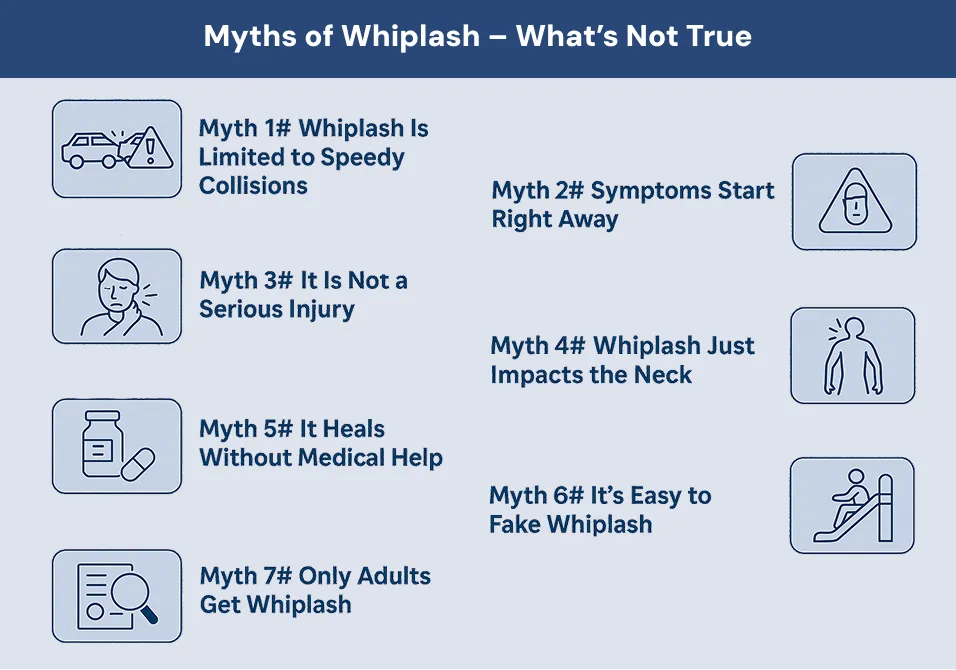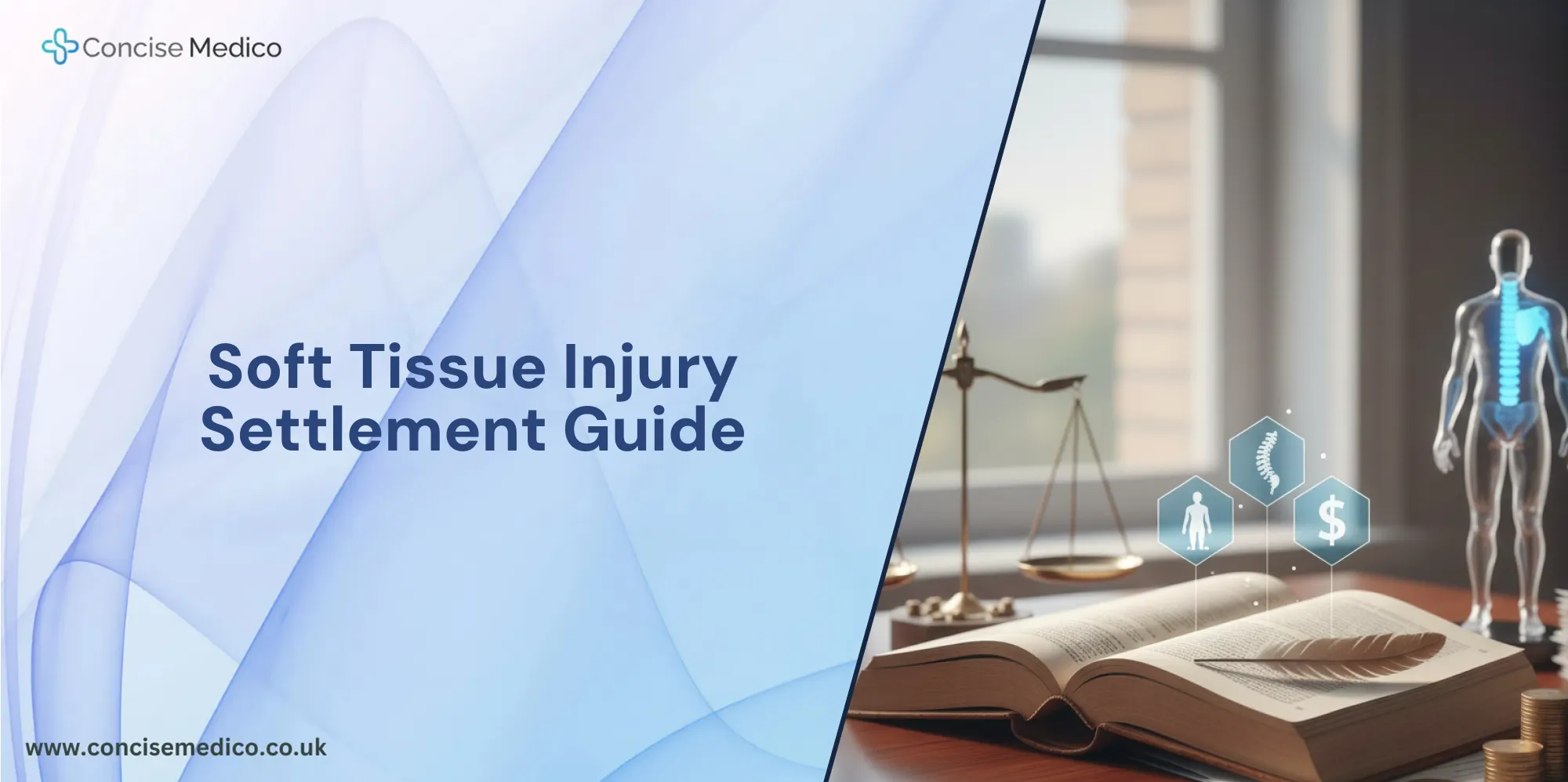TABLE OF CONTENT
Whiplash is a gentle tissue injury. Whiplash arises when the neck oscillates briskly in both directions. This commonly takes place in traffic collisions, notably when a vehicle is hit from the back. The sudden push applies stress to the neck muscles, ligaments, and joints. Nonetheless, there’s extra nuance to this condition than a lot of people understand. There are several myths of whiplash that mislead patients. This blog clears up common whiplash myths. It also points out key whiplash facts that everyone should be aware of.
Whiplash Facts You Ought to Be Aware
Some essential facts about whiplash are:
- It can happen at speeds as low as 5 mph.
- It doesn’t always trigger signs immediately.
- Kids and old people can get whiplash more easily. Their necks can not handle sudden jolts well, so small bumps can cause pain.
- Ignoring a sore neck early can make it hurt longer. Simple rest and gentle care right away can stop weeks of discomfort.
- Feeling upset after an injury is normal. If those feelings continue, they might lead to lasting stress.
According to the Association of British Insurers (ABI), over 1,500 whiplash claims are made each day in the UK. This shows how common and serious they are.
Myths of Whiplash – What’s Not True
Even though people are more aware, whiplash myths are still common. These myths make diagnosis and treatment harder. Let’s explore them one by one.
Myth 1# Whiplash Is Limited to Speedy Collisions
A common myth about whiplash is that it happens only in fast car crashes. But the truth is, even low-speed crashes or applying brakes suddenly can cause it. A whiplash injury does not occur due to overspeeding always. Even a fall, sports injury, or physical assault can lead to whiplash.
Myth 2# Symptoms Start Right Away
Another myth about whiplash is that symptoms develop promptly. In reality, signs may take hours or even days to emerge. These include:
- Neck pain and stiffness
- Headaches
- Dizziness
- Shoulder or back pain
- Difficulty in focus
Feeling “OK” right after an accident, does not mean that there won’t be any symptoms later. You must consult your doctor as soon as possible.

Whiplash injuries result in “temporary discomfort,” are “usually self-limited,” and have a “favorable prognosis,” and that the “pain [resulting from whiplash injuries] is not harmful.”
M D Freeman et al
Read details about whiplash symptoms.
Myth 3# It Is Not a Serious Injury
This is one of the most misleading whiplash myths. Some believe it’s “just a sore neck” and ignore it. If left untreated, whiplash can cause:
- Chronic pain
- Limited movement
- Muscle spasms
- Sleep disturbances
A few patients feel depression or anxiety because of ongoing pain. Treating whiplash early can prevent this.
Myth 4# Whiplash Just Impacts the Neck
One of the lesser-discussed whiplash facts is that it doesn’t just affect the neck. The pain can travel to:
- Shoulders
- Upper back
- Arms
- Jaws
Many people display vision issues. They might also perceive a ringing noise termed tinnitus. Whiplash can sway the whole body, not solely the neck.
Myth 5# It Heals Without Medical Help
This myth often leads to prolonged suffering. While minor whiplash can heal with rest, many cases need:
- Physiotherapy
- Medication
- Heat and cold therapy
- Gentle exercises
Ignoring treatment can cause long-term disability. That’s why recognising the key whiplash facts is necessary for improvement.
Myth 6# It’s Easy to Fake Whiplash
Several insurers and citizens wrongly perceive that whiplash symptoms can be easily faked. Diagnosing whiplash by an expert involves:
- Physical exams
- Range of motion tests
- Imaging studies (X-rays, MRI)
- Patient history and symptom tracking
Healthcare professionals use these methods to confirm injury. Faking whiplash is much harder than people think.
Myth 7# Only Adults Get Whiplash
A lot of people assume that only adults get whiplash injury, yet kids are also vulnerable. Their neck muscles are weaker. Their heads are larger in proportion. This makes them more vulnerable to injury during:
- Playground falls
- Bike crashes
- Car accidents
If a child reports neck pain following an injury, pediatric care is necessary.
Emotional and Mental Impact of Whiplash
Emotional Symptoms
While many focus on physical symptoms, emotional effects also matter. Some patients experience:
- Post-traumatic stress
- Fear of driving
- Low mood or anxiety
Mental Health Support
Emotional Symptoms are often overlooked but they are important. Knowing this is a crucial part of whiplash facts. Rehabilitation involves both the body and the mind equally.
Emotional turmoil can break your sleep, mindfulness, and relationships. If neglected, it can deteriorate over time and disrupt daily activities. As a result, mental health resources ought to be a part of a holistic recovery approach.
Myths Can Delay Recovery
By believing any of these myths and ignoring your pain or suffering will have a negative impact on your life. Thinking pain will just “go away” might stop someone from seeking care. This can make recovery harder and longer.
Believing in whiplash misconceptions can lead to:
- Misdiagnosis
- Ignoring symptoms
- Poor treatment choices
- Delayed recovery
- Other medical complications
It is in your best interest to consult your doctor as early as possible. It will help prevent complications and lowers the chance of chronic pain.
Whiplash Facts: Know the Truth
Whiplash has many myths that make it hard for people to understand the condition. Here’s a short recap of primary whiplash facts:
- It can occur at any speed
- Children are not immune to injuries
- It can lead to long-term pain
- Mental health is also affected
- Symptoms may be delayed
Grasping the details regarding whiplash facts can promote speedy recovery.
Need Help with Whiplash Recovery?
Don’t let myths about whiplash stop you from getting better. If you experience a whiplash related injury, don’t delay. Get checked and move on to the path of recovery sooner, if required.
Concise Medico administers expert aid for whiplash diagnosis and rehabilitation in both physical (Physiotherapy) and psychological (CBT, EMDR) injuries.

Connect with us today and let us guide you on the way to full recovery.
FAQs
Whiplash is a gentle tissue injury. Whiplash arises when the neck oscillates briskly in both directions. This commonly takes place in traffic collisions, notably when a vehicle is hit from the back. The sudden push applies stress to the neck muscles, ligaments, and joints. Nonetheless, there’s extra nuance to this condition than a lot of people understand. There are several myths of whiplash that mislead patients. This blog clears up common whiplash myths. It also points out key whiplash facts that everyone should be aware of.
Whiplash Facts You Ought to Be Aware
Some essential facts about whiplash are:
- It can happen at speeds as low as 5 mph.
- It doesn’t always trigger signs immediately.
- Kids and old people can get whiplash more easily. Their necks can not handle sudden jolts well, so small bumps can cause pain.
- Ignoring a sore neck early can make it hurt longer. Simple rest and gentle care right away can stop weeks of discomfort.
- Feeling upset after an injury is normal. If those feelings continue, they might lead to lasting stress.
According to the Association of British Insurers (ABI), over 1,500 whiplash claims are made each day in the UK. This shows how common and serious they are.
Myths of Whiplash – What’s Not True
Even though people are more aware, whiplash myths are still common. These myths make diagnosis and treatment harder. Let’s explore them one by one.
Myth 1# Whiplash Is Limited to Speedy Collisions
A common myth about whiplash is that it happens only in fast car crashes. But the truth is, even low-speed crashes or applying brakes suddenly can cause it. A whiplash injury does not occur due to overspeeding always. Even a fall, sports injury, or physical assault can lead to whiplash.
Myth 2# Symptoms Start Right Away
Another myth about whiplash is that symptoms develop promptly. In reality, signs may take hours or even days to emerge. These include:
- Neck pain and stiffness
- Headaches
- Dizziness
- Shoulder or back pain
- Difficulty in focus
Feeling “OK” right after an accident, does not mean that there won’t be any symptoms later. You must consult your doctor as soon as possible.

Whiplash injuries result in “temporary discomfort,” are “usually self-limited,” and have a “favorable prognosis,” and that the “pain [resulting from whiplash injuries] is not harmful.”
M D Freeman et al
Read details about whiplash symptoms.
Myth 3# It Is Not a Serious Injury
This is one of the most misleading whiplash myths. Some believe it’s “just a sore neck” and ignore it. If left untreated, whiplash can cause:
- Chronic pain
- Limited movement
- Muscle spasms
- Sleep disturbances
A few patients feel depression or anxiety because of ongoing pain. Treating whiplash early can prevent this.
Myth 4# Whiplash Just Impacts the Neck
One of the lesser-discussed whiplash facts is that it doesn’t just affect the neck. The pain can travel to:
- Shoulders
- Upper back
- Arms
- Jaws
Many people display vision issues. They might also perceive a ringing noise termed tinnitus. Whiplash can sway the whole body, not solely the neck.
Myth 5# It Heals Without Medical Help
This myth often leads to prolonged suffering. While minor whiplash can heal with rest, many cases need:
- Physiotherapy
- Medication
- Heat and cold therapy
- Gentle exercises
Ignoring treatment can cause long-term disability. That’s why recognising the key whiplash facts is necessary for improvement.
Myth 6# It’s Easy to Fake Whiplash
Several insurers and citizens wrongly perceive that whiplash symptoms can be easily faked. Diagnosing whiplash by an expert involves:
- Physical exams
- Range of motion tests
- Imaging studies (X-rays, MRI)
- Patient history and symptom tracking
Healthcare professionals use these methods to confirm injury. Faking whiplash is much harder than people think.
Myth 7# Only Adults Get Whiplash
A lot of people assume that only adults get whiplash injury, yet kids are also vulnerable. Their neck muscles are weaker. Their heads are larger in proportion. This makes them more vulnerable to injury during:
- Playground falls
- Bike crashes
- Car accidents
If a child reports neck pain following an injury, pediatric care is necessary.
Emotional and Mental Impact of Whiplash
Emotional Symptoms
While many focus on physical symptoms, emotional effects also matter. Some patients experience:
- Post-traumatic stress
- Fear of driving
- Low mood or anxiety
Mental Health Support
Emotional Symptoms are often overlooked but they are important. Knowing this is a crucial part of whiplash facts. Rehabilitation involves both the body and the mind equally.
Emotional turmoil can break your sleep, mindfulness, and relationships. If neglected, it can deteriorate over time and disrupt daily activities. As a result, mental health resources ought to be a part of a holistic recovery approach.
Myths Can Delay Recovery
By believing any of these myths and ignoring your pain or suffering will have a negative impact on your life. Thinking pain will just “go away” might stop someone from seeking care. This can make recovery harder and longer.
Believing in whiplash misconceptions can lead to:
- Misdiagnosis
- Ignoring symptoms
- Poor treatment choices
- Delayed recovery
- Other medical complications
It is in your best interest to consult your doctor as early as possible. It will help prevent complications and lowers the chance of chronic pain.
Whiplash Facts: Know the Truth
Whiplash has many myths that make it hard for people to understand the condition. Here’s a short recap of primary whiplash facts:
- It can occur at any speed
- Children are not immune to injuries
- It can lead to long-term pain
- Mental health is also affected
- Symptoms may be delayed
Grasping the details regarding whiplash facts can promote speedy recovery.
Need Help with Whiplash Recovery?
Don’t let myths about whiplash stop you from getting better. If you experience a whiplash related injury, don’t delay. Get checked and move on to the path of recovery sooner, if required.
Concise Medico administers expert aid for whiplash diagnosis and rehabilitation in both physical (Physiotherapy) and psychological (CBT, EMDR) injuries.

Connect with us today and let us guide you on the way to full recovery.




